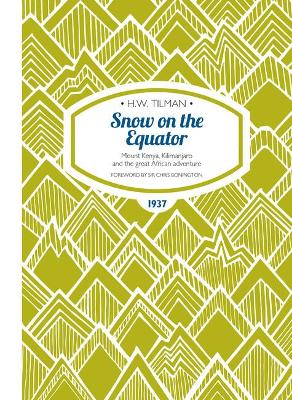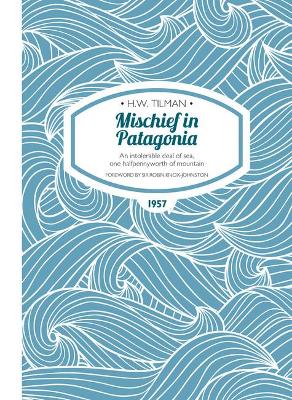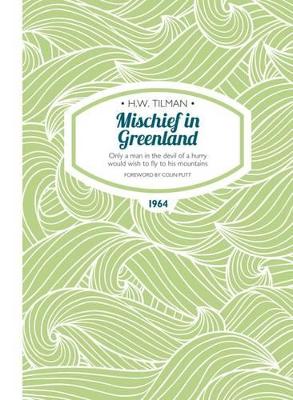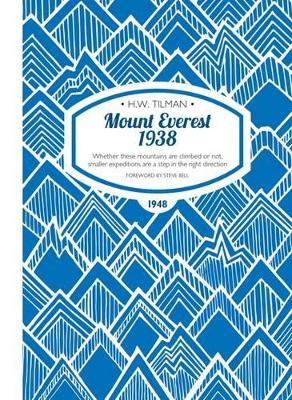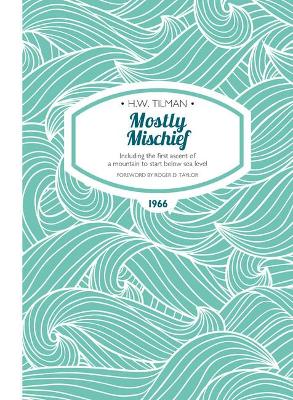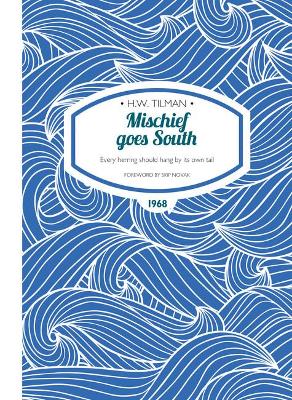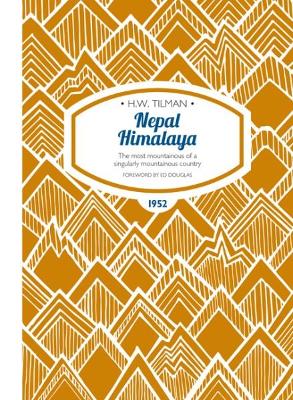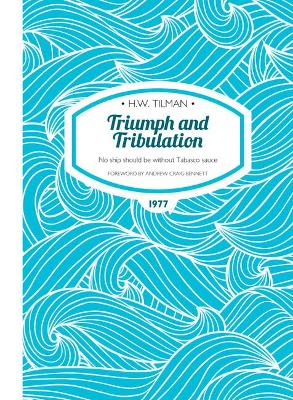H.W. Tilman: The Collected Edition
16 primary works • 17 total works
Book 1
'To those who went to the War straight from school and survived it, the problem of what to do afterwards was peculiarly difficult.'
For H.W. 'Bill' Tilman, the solution lay in Africa: in gold prospecting, mountaineering and a 3,000-mile bicycle ride across the continent. Tilman was one of the greatest adventurers of his time, a pioneering climber and sailor who held exploration above all else. He made first ascents throughout the Himalaya, attempted Mount Everest, and sailed into the Arctic Circle. For Tilman, the goal was always to explore, to see new places, to discover rather than conquer.
First published in 1937, Snow on the Equator chronicles Tilman's early adventures; his transition from East African coffee planter to famed mountaineer. After World War I, Tilman left for Africa, where he grew coffee, prospected for gold and met Eric Shipton, the two beginning their famed mountaineering partnership, traversing Mount Kenya and climbing Kilimanjaro and Ruwenzori. Tilman eventually left Africa in typically adventurous style via a 3,000-mile solo bicycle ride across the continent - all recounted here in splendidly funny style.
Tilman is one of the greatest of all travel writers. His books are well-informed and keenly observed, concerned with places and people as much as summits and achievements. They are full of humour and anecdotes and are frequently hilarious. He is part of the great British tradition of comic writing and there is nobody else quite like him.
Book 2
'So I began thinking again of those two white blanks on the map, of penguins and humming birds, of the pampas and of gauchos, in short, of Patagonia, a place where, one was told, the natives' heads steam when they eat marmalade.'
So responded H.W. 'Bill' Tilman to his own realisation that the Himalaya were too high for a mountaineer now well into his fifties. He would trade extremes of altitude for the romance of the sea with, at his journey's end, mountains and glaciers at a smaller scale; and the less explored they were, the better he would like it. Within a couple of years he had progressed from sailing a 14-foot dinghy to his own 45-foot pilot cutter Mischief, readied for her deep-sea voyaging, and recruited a crew for his most ambitious of private expeditions.
Well past her prime, Mischief carried Tilman, along with an ex-dairy farmer, two army officers and a retired civil servant, safely the length of the North and South Atlantic oceans, and through the notoriously difficult Magellan Strait, against strong prevailing winds, to their icy landfall in the far south of Chile.
The shore party spent six weeks crossing the Patagonian ice cap, in both directions, returning to find that their vessel had suffered a broken propeller. Edging north under sail only, Mischief put into Valparaiso for repairs, and finally made it home to Lymington via the Panama Canal, for a total of 20,000 nautical miles sailed, in addition to a major exploration 'first' all here related with the Skipper's characteristic modesty and bone-dry humour, and many photographs.
Book 3
Book 3
In 1934, after fifty years of trying, mountaineers finally gained access to the Nanda Devi Sanctuary in the Garhwal Himalaya.
Two years later an expedition led by H.W. Tilman reached the summit of Nanda Devi. At over 25,000 feet, it was the highest mountain to be climbed until 1950.
The Ascent of Nanda Devi, Tilman's account of the climb, has been widely hailed as a classic. Keenly observed, well informed and at times hilariously funny, it is as close to a 'conventional' mountaineering account as Tilman could manage. Beginning with the history of the mountain ('there was none') and the expedition's arrival in India, Tilman recounts the build-up and approach to the climb.
Writing in his characteristic dry style, he tells how Sherpas are hired, provisions are gathered (including 'a mouth-blistering sauce containing 100 per cent chillies') and the climbers head into the hills, towards Nanda Devi. Superbly parodied in The Ascent of Rum Doodle by W.E. Bowman, The Ascent of Nanda Devi was among the earliest accounts of a climbing expedition to be published. Much imitated but rarely matched, it remains one of the best.
Book 4
'Hand (man) wanted for long voyage in small boat. No pay, no prospects, not much pleasure.'
So read the crew notice placed in the personal column of The Times by H.W. 'Bill' Tilman in the spring of 1959. This approach to selecting volunteers for a year-long voyage of 20,000 miles brought mixed seafaring experience: 'Osborne had crossed the Atlantic fifty-one times in the Queen Mary, playing double bass in the ship's orchestra'.
With unclimbed ice-capped peaks and anchorages that could at best be described as challenging, the Southern Ocean island groups of Crozet and Kerguelen provided obvious destinations for Tilman and his fifty-year-old wooden pilot cutter Mischief. His previous attempt to land in the Crozet Islands had been abandoned when their only means of landing was carried away by a severe storm in the Southern Ocean.
Back at Lymington, a survey of the ship uncovered serious Teredo worm damage. Tilman, undeterred, sold his car to fund the rebuilding work and began planning his third sailing expedition to the southern hemisphere.
Mischief among the Penguins (1961), Tilman's account of landfalls on these tiny remote volcanic islands, bears testament to the development of his ocean navigation skills and seamanship. The accounts of the island anchorages, their snow-covered heights, geology and in particular the flora and fauna pay tribute to the varied interests and ingenuity of Mischief's crew, not least after several months at sea when food supplies needed to be eked out. Tilman's writing style, rich with informative and entertaining quotations, highlights the lessons learned with typical self-deprecating humour, while playing down the immensity of his achievements.
Book 5
Book 6
'Only a man in the devil of a hurry would wish to fly to his mountains, forgoing the lingering pleasure and mounting excitement of a slow, arduous approach under his own exertions.'
H.W. 'Bill' Tilman's mountain travel philosophy, rooted in Africa and the Himalaya and further developed in his early sailing adventures in the southern hemisphere, was honed to perfection with his discovery of Greenland as the perfect sailing destination. His Arctic voyages in the pilot cutter Mischief proved no less challenging than his earlier southern voyages. The shorter elapsed time made it rather easier to find a crew but the absence of warm tropical passages meant that similar levels of hardship were simply compressed into a shorter timescale.
First published fifty years before political correctness became an accepted rule, Mischief in Greenland is a treasure trove of Tilman's observational wit. In this account of his first two West Greenland voyages, he pulls no punches with regard to the occasional failings, leaving the reader to seek out and discover the numerous achievements of these voyages. The highlight of the second voyage was the identification, surveying and successful first ascent of Mount Raleigh, first observed on the eastern coast of Baffin Island by the Elizabethan explorer John Davis in 1585. For the many sailors and climbers who have since followed his lead and ventured north into those waters, Tilman provides much practical advice, whether from his own observations or those of Davis and the inimitable Captain Lecky. Tilman's typical gift of understatement belies his position as one of the greatest explorers and adventurers of the twentieth century.
Book 7
'Whether these mountains are climbed or not, smaller expeditions are a step in the right direction.'
It's 1938, the British have thrown everything they've got at Everest but they've still not reached the summit. War in Europe seems inevitable; the Empire is shrinking. Still reeling from failure in 1936, the British are granted one more permit by the Tibetans, one more chance to climb the mountain. Only limited resources are available, so can a small team be assembled and succeed where larger teams have failed?
H.W. Tilman is the obvious choice to lead a select team made up of some of the greatest British mountaineers history has ever known, including Eric Shipton, Frank Smythe and Noel Odell. Indeed, Tilman favours this lightweight approach. He carries oxygen but doesn't trust it or think it ethical to use it himself, and refuses to take luxuries on the expedition, although he does regret leaving a case of champagne behind for most of his time on the mountain.
On the mountain, the team is cold, the weather very wintery. It is with amazing fortitude that they establish a camp six at all, thanks in part to a Sherpa going by the family name of Tensing. Tilman carries to the high camp, but exhausted he retreats, leaving Smythe and Shipton to settle in for the night. He records in his diary, 'Frank and Eric going well-think they may do it.' But the monsoon is fast approaching ...
In Mount Everest 1938, first published in 1948, Tilman writes that it is difficult to give the layman much idea of the actual difficulties of the last 2,000 feet of Everest. He returns to the high camp and, in exceptional style, they try for the ridge, the route to the summit and those immense difficulties of the few remaining feet.
Book 8
However many times it has been done, the act of casting off the warps and letting go one's last hold of the shore at the start of a voyage has about it something solemn and irrevocable, like marriage, for better or for worse.
Mostly Mischief's ordinary title belies four more extraordinary voyages made by H.W. 'Bill' Tilman covering almost 25,000 miles in both Arctic and Antarctic waters.
The first sees the pilot cutter Mischief retracing the steps of Elizabethan explorer John Davis to the eastern entrance to the Northwest Passage. Tilman and a companion land on the north coast and make the hazardous crossing of Bylot Island while the remainder of the crew make the eventful passage to the southern shore to recover the climbing party. Back in England, Tilman refuses to accept the condemnation of Mischief's surveyor, undertaking costly repairs before heading back to sea for a first encounter with the East Greenland ice.
Between June 1964 and September 1965, Tilman is at sea almost without a break. Two eventful voyages to East Greenland in Mischief provide the entertaining bookends to his account of the five-month voyage in the Southern Ocean as skipper of the schooner Patanela. Tilman had been hand-picked by the expedition leader as the navigator best able to land a team of Australian and New Zealand climbers and scientists on Heard Island, a tiny volcanic speck in the Furious Fifties devoid of safe anchorages and capped by an unclimbed glaciated peak. In a separate account of this successful voyage, Colin Putt describes the expedition as unique - the first ascent of a mountain to start below sea level.
Book 9
H.W. Tilman's Two Mountains and a River picks up where Mount Everest 1938 left off. In this instalment of adventures, Tilman and two Swiss mountaineers set off for the Gilgit region of the Himalaya with the formidable objective of an attempt on the giant Rakaposhi (25,550 feet). However, this project was not to be fulfilled.
Not one to be dispirited, Tilman and his various accomplices - including pioneering mountaineer and regular partner Eric Shipton - continue to trek and climb in locations across China, Pakistan, Afghanistan and other areas of Asia, including the Kukuay Glacier, Muztagh Ata, the source of the Oxus river, and Ishkashim, where the author was arrested on suspicion of being a spy ...
Two Mountains and a River brims with the definitive Tilman qualities - detailed observations and ever-present humour - that convey a strong appreciation of the adventures and mishaps he experiences along the way. With a new foreword from prominent trekker, climber and lecturer, Gerda Pauler, this classic mountaineering text maintains Tilman's name as a unique and inquisitive explorer and raconteur.
Book 10
'No sea voyage can be dull for a man who has an eye for the ever-changing sea and sky, the waves, the wind and the way of a ship upon the water.'
So observes H.W. 'Bill' Tilman in this account of two lengthy voyages in which dull intervals were few and far between.
In 1966, after a succession of eventful and successful voyages in the high latitudes of the Arctic, Tilman and his pilot cutter Mischief head south again, this time with the Antarctic Peninsula, Smith Island and the unclimbed Mount Foster in their sights. Mischief goes South is an account of a voyage marred by tragedy and dogged by crew trouble from the start. Tilman gives ample insight into the difficulties associated with his selection of shipmates and his supervision of a crew, as he wryly notes, 'to have four misfits in a crew of five is too many'.
The second part of this volume contains the author's account of a gruelling voyage south, an account left unwritten for ten years for lack of time and energy. Originally intended as an expedition to the remote Crozet Islands in the southern Indian Ocean, this 1957 voyage evolved into a circumnavigation of Africa, the unplanned consequence of a momentary lapse in attention by an inexperienced helmsman.
The two voyages described in Mischief goes South covered 43,000 miles over twenty-five months spent at sea and, while neither was deemed successful, published together they give a fine insight into Tilman's character.
Book 11
‘Upon this trackless waste of snow, cut by a shrewd wind they sat down and wept.’
In China to Chitral H.W. ‘Bill’ Tilman completes one of his great post-war journeys. He travels from Central China, crossing Sinkiang, the Gobi and Takla Makan Deserts, before escaping to a crumbling British Empire with a crossing of the Karakoram to the new nation of Pakistan.
In 1951 there still persisted a legend that a vast mountain, higher than Everest, was to be found in the region, a good enough reason it seems for Tilman to traverse the land, ‘a land shut in on three sides by vast snow ranges whose glacial streams nourish the oases and upon whose slopes the yaks and camels graze side by side; where in their felt yorts the Kirghiz and Kazak live much as they did in the days of Genghis Khan, except now they no longer take a hand in the devastation of Europe’.
Widely regarded as some of Tilman’s finest travel writing, China to Chitral is full of understatement and laconic humour, with descriptions of disastrous attempts on unclimbed mountains with Shipton, including Bogdo Ola—an extension of the mighty Tien Shan mountains— and the Chakar Aghil group near Kashgar on the old silk road. His command of the Chinese language—five words, all referring to food—proves less than helpful in his quest to find a decent meal: 'fortunately, in China there are no ridiculous hygienic regulations on the sale of food’. Tilman also has several unnerving encounters with less-than-friendly tribesmen …
Tilman starts proper in Lanchow where he describes with some regret that he is less a traveller and more a passenger on this great traverse of the central basin and rim of mountain ranges at Asia’s heart. But Tilman is one of our greatest ever travel writers, and we become a passenger to his adventurers.
Book 12
‘I felt like one who had first betrayed and then deserted a stricken friend; a friend with whom for the past fourteen years I had spent more time at sea than on land, and who, when not at sea, had seldom been out of my thoughts.’
The first of the three voyages described in In Mischief’s Wake gives H.W. ‘Bill’ Tilman’s account of the final voyage and loss of Mischief, the Bristol Channel pilot cutter in which he had sailed over 100,000 miles to high latitudes in both Arctic and Antarctic waters.
Back home, refusing to accept defeat and going against the advice of his surveyor, he takes ownership of Sea Breeze, built in 1899; ‘a bit long in the tooth, but no more so, in fact a year less, than her prospective owner’. After extensive remedial work, his first attempt at departure had to be cut short when the crew ‘enjoyed a view of the Isle of Wight between two of the waterline planks’. After yet more expense, Sea Breeze made landfall in Iceland before heading north toward the East Greenland coast in good shape and well stocked with supplies. A mere forty miles from the entrance to Scoresby Sound, Tilman’s long-sought-after objective, ‘a polite mutiny’ forced him to abandon the voyage and head home.
The following year, with a crew game for all challenges, a series of adventures on the west coast of Greenland gave Tilman a voyage he considered ‘certainly the happiest’, in a boat which was proving to be a worthy successor to his beloved Mischief.
Book 12
Book 13
Nepal Himalaya: The Most Mountainous of a Singularly Mountainous Country
by Major H. W. Tilman
Throughout 1949 and 1950 H.W. 'Bill' Tilman mounted pioneering expeditions to Nepal and its Himalayan mountains, taking advantage of some of the first access to the country for Western travellers in the 20th century. Tilman and his party-including a certain Sherpa Tenzing Norgay-trekked into the Kathmandu Valley and on to the Langtang region, where the highs and lows began.
They first explored the Ganesh Himal, before moving on to the Jugal Himal and the following season embarking on an ambitious trip to Annapurna and Everest. Manaslu was their first objective, but left to 'better men', and Annapurna IV very nearly climbed instead but for bad weather which dogged the whole expedition. Needless to say, Tilman was leading some very lightweight expeditions into some seriously heavyweight mountains.
After the Annapurna adventure Tilman headed to Everest with-among others-Dr Charles Houston. Approaching from the delights of Namche Bazaar, the party made progress up the flanks of Pumori to gaze as best they could into the Western Cwm, and at the South Col and South-East Ridge approach to the summit of Everest. His observations were both optimistic and pessimistic: 'One cannot write off the south side as impossible until the approach from the head of the West Cwm to this remarkably airy col has been seen.' But then of the West Cwm: 'A trench overhung by these two tremendous walls might easily become a grave for any party which pitched its camp there.'
Nepal Himalaya presents Tilman's favourite sketches, encounters with endless yetis, trouble with the porters, his obsessive relationship with alcohol and issues with the food. And so Tilman departs Nepal for the last time proper with these retiring words: 'If a man feels he is failing to achieve this stern standard he should perhaps withdraw from a field of such high endeavour as the Himalaya.'
Book 15
'Experience is said to be the name men give to their mistakes and of the experience I gained in Spitsbergen that may well be true.'
The circumnavigation of Spitsbergen is the first of three voyages described in H.W. 'Bill' Tilman's fifteenth and final book, a remarkable example of Tilman's ability to triumph when supported by a crew game for all challenges. The 1974 voyage of the pilot cutter Baroque takes Tilman to his furthest north--the highest latitude of any of his travels in the northern or southern hemisphere. The account of this achievement makes compelling reading, the crew pulling together to avert potential disaster from a navigational misjudgement.
A younger, less experienced crew join Tilman in 1975, this time heading north along Greenland's west coast until a break in the boom necessitates the abandonment of the objective and an early return. 'That one can never be quite confident of reaching any of the places I aim at may be part of their charm, and failure is at least an excuse for making another voyage.'
The following year proves to be Tilman's last voyage in his own boat, his account beginning with a dry nod to his artillery background: 'As I begin to describe this voyage, the discrepancy between the target and the fall of shot provokes a wry smile.'
Tilman never expected crews to pay, covering all the costs of his voyages personally. He therefore held the quite reasonable view that his crew would pull their weight, show loyalty to the ship and take the rough with the smooth. Sadly, the crew in 1976 fell far short of that expectation, forcing several changes of plan and eventually obliging Tilman to leave Baroque in Iceland. Not for the first time in Tilman's remarkable 140,000 miles of voyaging is he moved to quote Conrad: 'Ships are all right, it's the men in them.'
Tilman set a high standard and led by example; where his companions rose to the challenge, as they did in the majority of his expeditions, the results were often remarkable. Triumph and Tribulation, his fifteenth and final book, completes this newly extended edition of his literary legacy, a fine testament to a remarkable life.
